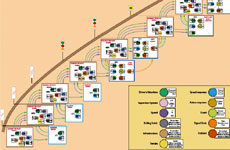
Categories
Publications
Probabilistic Safety Analysis of High Speed and Conventional Railway Lines
27/06/2018

A probabilistic safety analysis methodology based on Bayesian network model is presented, in which all the elements encountered when travelling along a railway line, such as terrain, infrastructure, tunnels, viaducts, light signals, speed limit signs, curves, switches, rolling stock, and any other element related to its safety are reproduced. Especial attention is given to human error and modelling the driver behaviour variables and their time evolution. The conditional probabilities of variables given their parents are given by means of closed formulas, which facilitate the software implementation of the proposed models. The model provides a probabilistic safety assessment of the line such that its most critical elements can be identified and sorted by importance. This permits improving the line safety and optimizing the maintenance program by concentrating on the most critical elements. To reduce the complexity of the problem, a method is given that divides the Bayesian network into small parts such that the complexity of the problem becomes linear in the number of items. In addition, when an accident occurs, a backward inference process allows us to identify the causes of incidents. The case of the real Palencia–Santander and Vitoria-Zaragoza lines together with some other simple examples are used to illustrate the advantages of the proposed methodology.
Download paper »


